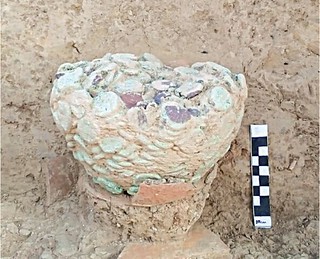
PREV ARTICLE
NEXT ARTICLE
FULL ISSUE
PREV FULL ISSUE
COPPER COIN POT UNEARTHED IN PAKISTANA pot of 2nd to 5th century copper coins has been discovered by archaeologists in Pakistan. -Editor
Mohenjo Daro, or Director of Archaeology Mohenjodaro, Dr Syed Shakir Shah, who led the team comprising archaeological conservator Ghulam Shabir Joyo, had confirmed that the staff busy with preservation work had stumbled upon the pot of coins on Wednesday.
Sheikh Javed Sindhi, who was engaged in research at the site, said that previously, 4,348 copper coins were excavated by R.D. Banerji, Sir John Marshall, and Mackay from 1922 to 1931. These coins belonged to the Kushan Period dating back to the 2 to 5 Century AD, he said.
Rustam Bhutto, in-charge of the soil and water testing laboratory, said the treatment process for separating the amalgamated coins would take at least a month to make the figures and language on coins visible.
Ali Haidar Gadhi, senior conservationist at said that Mr Banerji discovered nearly 2,000 coins, 338 of which were of the period of Kushan ruler Vasudeva-1 with standing royal figure on obverse and Shiva on the reverse and the bulk comprising 1,823 un-inscribed cast copper coins. While evidence from coins and inscriptions at Rabatak and Surkh Kotal clearly shows that the Kushans maintained Iranian religious beliefs and practices, other inscriptions show that Kushan officials under Kaniska and his successors patronized Buddhists. The fire altar on previously discovered coins has Iranian influences.
To read the complete article, see:
Wayne Homren, Editor The Numismatic Bibliomania Society is a non-profit organization promoting numismatic literature. See our web site at coinbooks.org. To submit items for publication in The E-Sylum, write to the Editor at this address: whomren@gmail.com To subscribe go to: https://my.binhost.com/lists/listinfo/esylum All Rights Reserved. NBS Home Page Contact the NBS webmaster 
|

